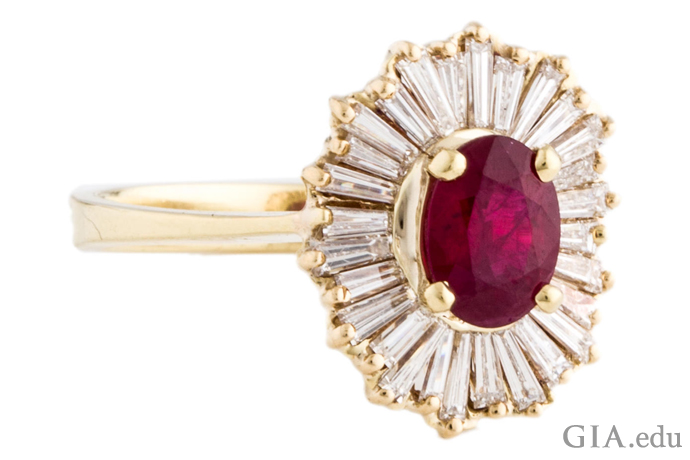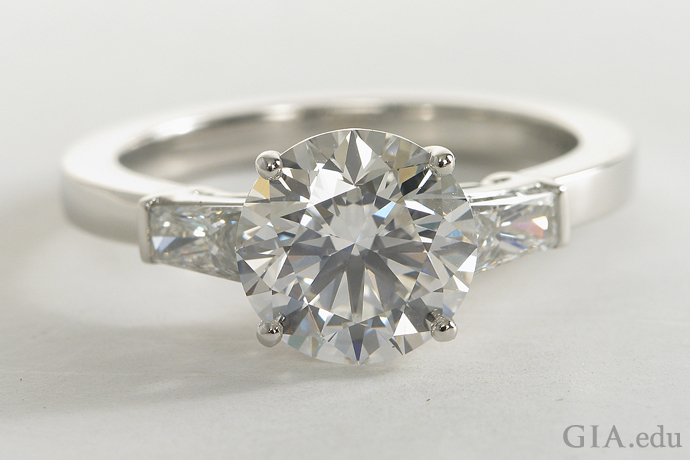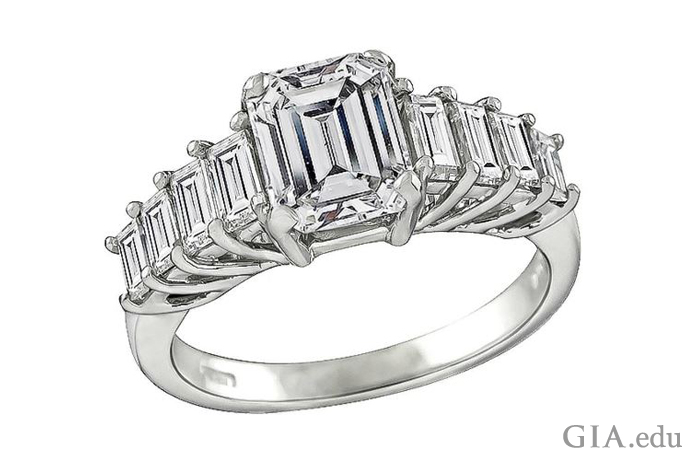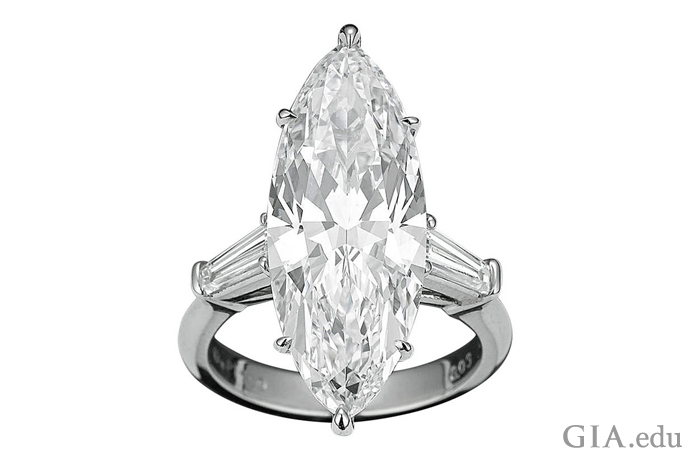A baguette diamond, usually set in multiples, adds a dash of style to an engagement ring – or any jewelry piece. Popular since the Art Deco era, this dazzling diamond cut should be part of your shopping vocabulary. Here’s what you need to know.
In this blog, we cover:
Baguette Diamond: A Definition
Baguette Diamond: A Brief History
Baguette Diamond: What to Look For
Baguette Diamond: A Definition
Baguettes are small, usually rectangular, step-cut diamonds with straight or tapered edges. Some baguettes are almost square, while others have a length-to-width ratio of 5:1 or even longer. A tapered baguette diamond has long sides that angle inwards. Baguettes are popular side stones in engagement rings.
 All the edges are parallel to each other in this baguette. Illustration: Peter Johnston/GIA |
 The long sides of a tapered baguette angle inwards. Illustration: Peter Johnston/GIA |

Channel-set tapered baguettes make these earrings visually arresting. Photo: Robert Weldon/GIA
Emerald cut diamonds are also rectangular or square step cuts. Unlike baguettes, though, they have diagonally cut—not square—corners.

An emerald cut diamond has diagonal corners. A baguette does not. Illustration: Peter Johnston/GIA
In a style called the ballerina setting, baguettes surround the center stone to form a skirt that resembles a ballerina’s tutu. While the tutu effect is best shown with tapered baguettes, so the skirt appears to flow out from the girdle of the center stone, other diamond shapes have also been used. For a ballerina setting, baguettes are typically channel set, though they are occasionally prong set.

Tapered baguettes in a prong setting are used to make this “ballerina setting,” which encircles the ruby. Courtesy: The RealReal
An attractive novelty cut is the brilliant baguette. This is primarily a mixed cut, with brilliant-style facets (triangular and kite shaped) on the pavilion and step-cut facets on the crown. A benefit of this style is that it can add more sparkle to your diamond engagement ring.

The top image is a tapered baguette diamond with brilliant-style facets on the pavilion and step-cut facets on the crown. The bottom image shows where the crown and pavilion facets are typically placed. Photo and Illustration: Al Gilbertson/GIA

Baguettes with a brilliant facet arrangement on the pavilion add even more visual fireworks to the 2.30 carat (ct) round brilliant center stone. Courtesy: Blue Nile
Dimensions are more important than weight when purchasing baguette diamonds, since they are usually sold in multiples. For example, if you were purchasing two of them–to sit on either side of a center stone–you or your jeweler would ask for two stones of equal dimensions – and not of equal carat weight.
Baguette Diamond: A Brief History
The origin of the term “baguette” for these small step-cut diamonds is up for debate. The traditional translation of the French word is “rod” or “stick,” but one meaning given in Randle Cotgrave’s 1673 French and English Dictionary is “a little jewel.” It is the diminutive of the French “bague,” which at the time meant “jewel” or, its current meaning, “ring.”
The rectangular step-cut diamond now called the baguette diamond is believed to have evolved from the hogback, an elongated table cut that was known since at least the mid-16th century. At that time, it was often used to make monograms and jeweled letters (like the owner’s initials). Cartier reintroduced the baguette cutting style in 1912, and in the following decades jewelry designers of the Art Deco period favored its clean lines and geometric shape. It was in the 20th century that the term “baguette” was first used in English to refer to this popular side stone as we know it today. Some think that the diamond cut was named after the long, thin loaf of French bread that it often resembles.

Six baguettes and 18 round brilliants border a 1.37 ct emerald cut diamond in this Art Deco ring (circa 1930s). The use of geometric shapes is a defining characteristic of the period. Courtesy: 1stdibs.com

Another Art Deco treasure, this engagement ring features a 2.40 ct emerald cut center stone, 0.85 carats of baguettes and triangular diamonds, and 0.96 carats of trilliant cut synthetic rubies. Courtesy: The RealReal
The baguette diamond is frequently used in contemporary jewelry and engagement rings. So if you want a modern version of an Art Deco engagement ring, consider one with baguettes.

A bonanza of baguette diamonds with a total weight of approximately 0.70 carats, these slender beauties bring a majestic look to the 1.79 ct center stone. The ring, a contemporary creation, shows that the Art Deco look is alive and well. Courtesy: 1stdibs.com
Baguette Diamond: What to Look For
Here are some tips for picking beautiful baguette diamond:
- Baguettes that fall toward the top of the D-to-Z color range are often prized.

An 8.03 ct D-color marquise diamond is the unquestioned star in this ring. Two flanking baguette diamonds play a supporting role: Their colors blend seamlessly and do not detract from the diamond’s beauty. Courtesy: 1stdibs.com
- All the baguettes in the ring should be similar in color and clarity, and they should match the center diamond. A baguette diamond whose color or clarity is noticeably different from another or from the center stone is likely to create an inharmonious and unappealing appearance.
- Step cut means that the crown facets of the baguette are arranged in a terrace-like fashion parallel to the table edges. Slight deviations in the facets’ symmetry are usually visible to the naked eye and detract from the stone. Make sure all facets are parallel and symmetrical.
- Avoid inclusions – they are usually more visible in a baguette diamond than a round brilliant.
- Baguettes and tapered baguettes are purchased in sets. For simple accent stones on the shoulder of a ring, you may want one, two or three (for example) baguettes or tapered baguettes on each shoulder. They will need to match in length and width (and taper) to fit the channels. For straight baguettes, you will need to specify the length and width to 0.1 millimeter (mm) for a good match. For tapered baguettes, you’ll need to specify the wide and narrow end widths to 0.1 mm.
To create a long curve, buy the appropriate number of tapered baguettes that range in length from X to Y, depending on the type of width range you want that curve to be. The stronger the taper, the sharper the curve, so ask for diamonds with a slight or strong taper. - Like most other diamonds, baguettes can be treated to enhance their appearance. Treatments may include high pressure, high temperature (HPHT) to enhance color or fracture filling to enhance apparent clarity. Synthetic diamond baguettes are also available in the marketplace. By law, a retailer must disclose if the diamonds you are purchasing are natural, treated or synthetic.

A 2.01 ct E-color SI1 emerald cut diamond is flanked by two tapered baguettes weighing approximately 0.35 carats in total. Baguettes mismatched in color or clarity would detract from the aristocratic splendor of the ring. Courtesy: 1stdibs.com
Baguette diamonds bring understated elegance wherever they are used. But there are other small diamonds to consider – particularly if you’re looking to add high drama and sparkle to your engagement ring. Meet melee diamonds and get to know these tiny diamonds with big impact.







